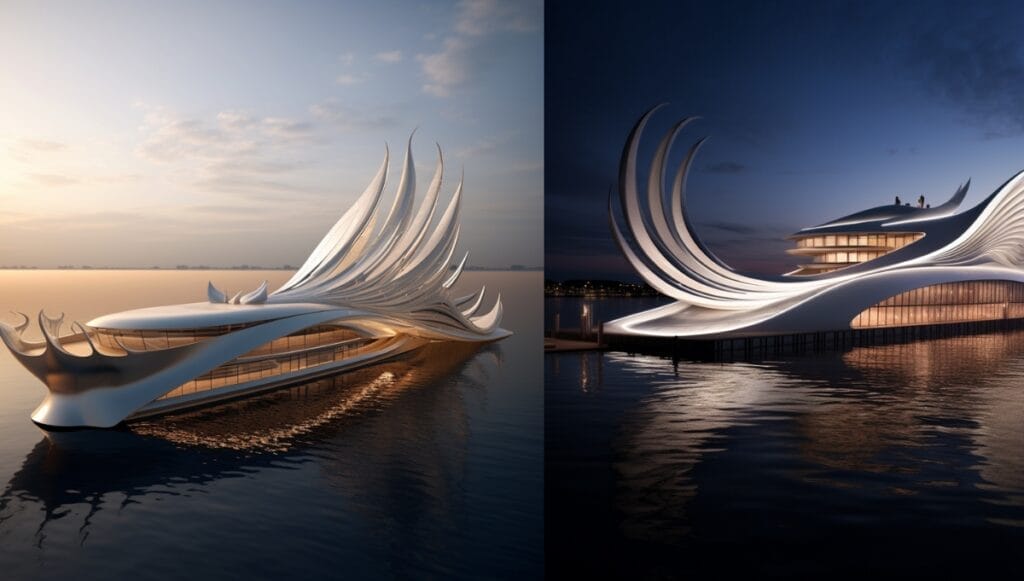The useful application of AI extends right across the industry – from design and management to navigation and energy optimisation.
By Julia Zaltzman
In the bespoke world of superyachts, artificial intelligence (AI) has emerged as an unexpected ally. Within computer-generated yacht design, it’s given a lease of life to endless creative possibilities and added a thick layer of convenience to tedious administrative tasks. For Rob Armstrong, creative director of ThirtyC Yacht Design, programs like Midjourney have brought speed and efficiency to his drawing board.
“I consider AI to be a valuable tool to explore different ideas quickly,” he says. “I feed it my original sketches as a starting point, and it takes me down interesting routes that may not have naturally occurred to me.”
Dutch design studio Vripack is no stranger to innovation. It was among the first to apply virtual reality and advanced gaming software to its design process. Co-creative director Marnix Hoekstra says the practicalities around AI focus on reshaping how yacht designers work. “It’s an effective tool for creating quick visual representations of a sketched concept in a more efficient way,” he says.

A new ally for the entire industry?
Some programmes require text prompts to kickstart the process, while other AI algorithms simulate or optimise renderings, and even highlight aspects that aren’t working. For all the grey lines around copyright infringement and lack of original thought, the real potential lies at the core of AI’s machine learning software. It’s for this reason that AI’s application within yachting extends beyond the design studio. Shipyards and yacht management companies have integrated it into their systems to streamline processes and, in some cases, implement real change.
IYC was among the first to introduce artificial intelligence to its virtual yacht management system, BLUE, in 2023. The proprietary support software, created and implemented in-house, uses a virtual yacht manager named ‘Anna’. It has multi-layers of programmed intelligence to quickly and accurately automate administrative tasks and compliance requirements for crew, safety and document management. That includes rapidly responding to captain’s clerical requests, increasing efficiency for shoreside yacht managers and removing human error from the equation.
“BLUE is not about replacing people,” says Celine Robins, IYC’s global yacht management director. “It’s about taking care of organisational needs so that our shoreside yacht managers can focus on the daily operations of the vessel and bring personalised support to the captain on the phone.”
Keeping track of certificates, insurances, safety deadlines and finances are just a few of the administrative tasks performed by BLUE. It also alerts the chief officer when an engine service is due or critical equipment parts are required, and produces a list of local service providers wherever the yacht happens to be in the world. According to Robins, BLUE converts 30 hours of human work into one minute of artificial intelligence, which saves time and money.

Helping to reduce yachting’s environmental impact
Videoworks’ AI installation, which it developed in partnership with the University of Pisa, debuted at the Monaco Yacht Show in September. It both monitors and optimises onboard functions to improve guest comfort and reduce a yacht’s energy and environmental impact.
The first iteration of the software named Rossinavi AI is installed aboard Rossinavi’s new hybrid electric catamaran, Seawolf X. Compared to a traditional 500 GT yacht that consumes between 45,000 and 55,000 litres of diesel to travel approximately 3,500 nautical miles, Seawolf X can cover 3,800 nautical miles on just 15,000 litres of fuel thanks to AI efficiencies.
“The installation of an artificial intelligence system focused on power management aboard yachts represents a significant innovation in the maritime sector, aimed at optimising fuel consumption and supporting the crew,” says Claudia Rossi, Rossinavi’s chief commercial officer. “It facilitates efficient navigation and marks a tangible step toward the yachts of the future.”

Since Seawolf X delivered to her owner in August, the AI algorithms have already accumulated valuable information through machine learning. They work in tandem with a series of sensors that are fitted throughout the yacht. These include checking when guests are present in their cabins so that blinds can be lowered, lights switched off, or the air conditioning units from overloading. The interior lighting automatically brightens or dims depending on the time of day and amount of exterior sunlight.
Even more crucially, it assists with navigation, measuring the strength of currents and wind direction to help keep the yacht on course. It also monitors the battery charge and decreases the yacht’s speed accordingly to guarantee reaching safe harbour, and sends an alert to the captain when the hull requires cleaning to ensure the yacht sails as efficiently as possible.
It’s a similar story with DSNM’s bespoke navigational management system, Compass, which uses ChatGPT to produce live weather reports based on a yacht’s geographically tagged location. Over time, the system learns weather patterns, which helps with itinerary planning and enhances crew safety during voyages.
Even crew recruitment companies, such as CrewPass, now implement AI to carry out efficient crew background checks and scan vast datasets to quickly identify suitable candidates.
The yachting industry will always be reliant on the valuable human element, particularly when it comes to personalised crew service, yet the efficiencies that can be gained using advanced AI software signal a permanent sea change.
Credits: thesuperyachtlife.com
